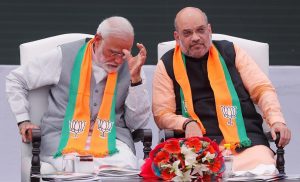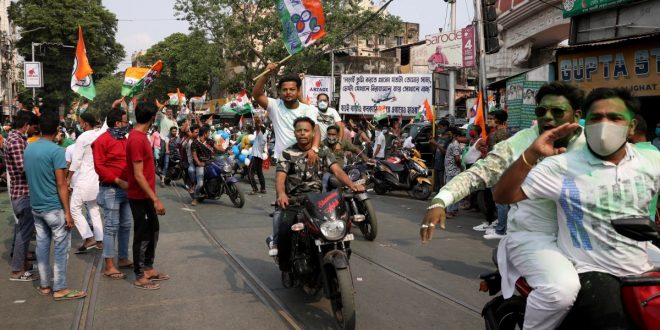03-05-2021
By SJA Jafri + Bureau Report + Agencies
NEW DELHI: The incumbent chief minister’s party in India’s West Bengal state has defeated Prime Minister Narendra Modi’s party in state elections held as the coronavirus pandemic surged to crisis levels.
Modi has been criticized for focusing on the elections instead of making the pandemic his top priority.
Some experts blame the federal election commission for allowing rallies and voting in which large crowds flouted rules on social distancing and mask-wearing.
Mamata Banerjee, 66, is set to be the chief minister of West Bengal for the third time after her Trinamool Congress party (TMC) won a two-thirds majority, taking more than 200 seats in the 294-seat state assembly, election commission officials said. Final counting for some seats was still under way.
Banerjee is currently India’s only female chief minister.
In a victory speech on Sunday, Banerjee said West Bengal’s “immediate challenge is to combat COVID-19 and we are confident that we will win”.
“This victory has saved the humanity, the people of India. It’s the victory of India,” Banerjee, a fierce critic of Modi, added.
Despite the defeat, Modi’s Bharatiya Janata Party (BJP) made substantial gains in West Bengal, making it the main opposition party as its tally in the state legislature went to nearly 80 seats from just three seats won in 2016.
 Modi, his colleagues and regional politicians campaigned aggressively in five state elections despite the pandemic.
Modi, his colleagues and regional politicians campaigned aggressively in five state elections despite the pandemic.
The results are seen as a test of the effect the pandemic’s second wave is having on support for him and his right-wing BJP.
On Sunday, India recorded its deadliest day of the coronavirus pandemic yet with 3,689 deaths in the last 24 hours
The number of cases surged to 19.5 million on Sunday with 392,488 new infections, government data showed. India became the first country to cross 400,000 daily cases on Saturday.
“This election verdict is as much an endorsement of Mamata Banerjee as it is a critique or a verdict against Modi and his government’s handling of the COVID crisis,” sources told PMI.
“The people in India are suffering. There’s lots of pain misery and despair. And this was the first time they had an opportunity to give expression to that anger, to give expression to that pain, and they appear to have done it in a resounding manner in West Bengal,” he said.
‘Stupendous performance’
Banerjee, a sharp critic of Modi, largely conducted a one-woman campaign to retain power by leading scores of public rallies.
“It is a stupendous performance by Mamata Banerjee because Modi was determined to win Bengal, but it’s clear that his entire political machinery and strategy was unable to defeat her,” Diptendu Bhaskar, a political analyst in Kolkata, West Bengal’s capital, told media.
 Sources reporting from the national capital, New Delhi, said supporters of Banerjee were celebrating her victory in Kolkata despite the election commission banning all celebrations because of India’s large number of COVID-19 cases.
Sources reporting from the national capital, New Delhi, said supporters of Banerjee were celebrating her victory in Kolkata despite the election commission banning all celebrations because of India’s large number of COVID-19 cases.
“From our hearts, we have good wishes for Mamata Banerjee and that is why we are celebrating,” one supporter said.
“We knew the TMC would win because the development [in West Bengal] has been all done by TMC.”
Another source told PMI that West Bengal was never the BJP stronghold but they mounted a “very spirited challenge”.
“His (Modi’s) party has an absolute majority in parliament. So there is no threat to his government, and the national elections are three and a half years from now”, “but nonetheless, for the first time, the broad contours of an emergent challenge are beginning to appear”, he said.
In Assam state, the BJP managed to retain political power. In Tamil Nadu, the DMK, the main regional opposition party, secured victory.
In Kerala state, the ruling Left Democratic Front (LDF) was set to form the government, while the BJP led-alliance won no seats. In the union territory of Puducherry, the All India NR Congress-led alliance was leading in 14 of the 30 assembly seats.
Most of the votes were cast in March, but polling in some constituencies continued through April, just as India started to detect thousands of new coronavirus infections every day.
 Pressmediaofindia
Pressmediaofindia




